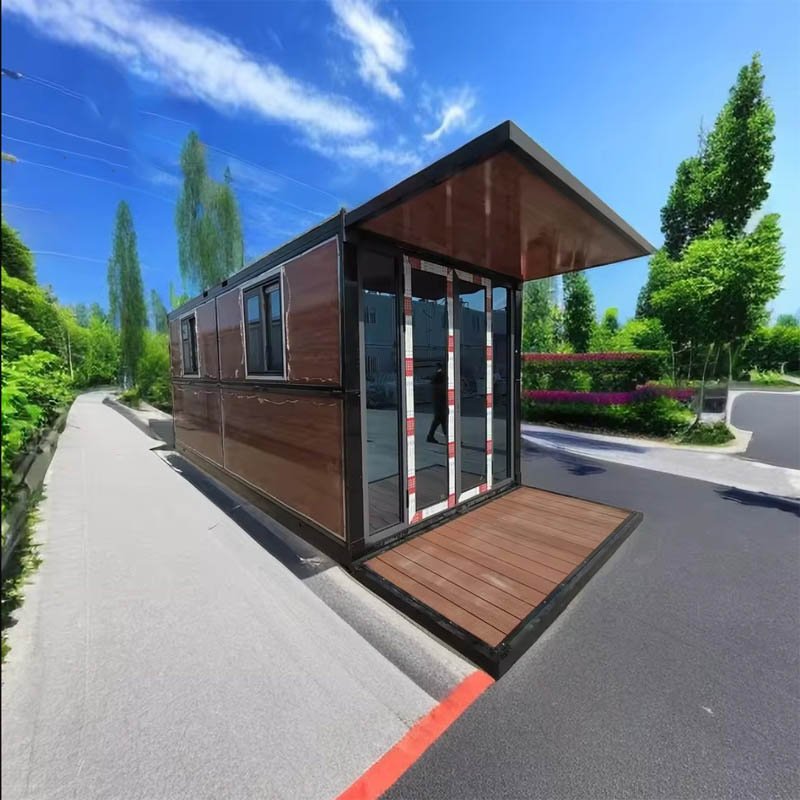What Makes a Foldable House the Smartest Modern Living Choice Today?
2025-11-19
A foldable house represents a new generation of modular living structures designed for rapid deployment, flexible usage, and long-term durability. This concept focuses on compact transport, fast installation, and multifunctional applications across residential, commercial, and emergency sectors. As global trends shift toward mobility, affordability, and sustainability, the foldable house provides a practical solution for users who require efficient space utilization without compromising safety or comfort.
What Is a Foldable House and What Core Features Define Its Value?
A foldable house is a prefabricated structure engineered to fold into a compact form for transportation and unfold into a full-size living or working space within minutes. Its design prioritizes portability and structural integrity, making it suitable for permanent residences, mobile offices, disaster-relief shelters, remote mining camps, military field stations, tourism accommodations, and temporary construction sites. The core objective is to provide a highly efficient housing solution that balances mobility and stability.
1. Structural Concept: What Makes the Foldable System Work?
The foldable house uses a hinge-based framework integrated into steel, galvanized materials, or durable metal alloys. These components allow the house to collapse flat without damaging the walls, insulation, or internal systems. Once unfolded, the structure locks into position using built-in mechanical fasteners, ensuring rigidity comparable to conventional modular buildings.
2. Material Composition: What Ensures Durability and Safety?
High-strength steel frames provide robust load-bearing capacity, while wall panels typically use fire-resistant and waterproof materials such as rock wool, PU foam, or EPS sandwich boards. Many designs include insulation layers to maintain indoor temperature stability, making foldable houses suitable for hot, cold, and humid climates.
3. Product Parameters (Professional List)
Below is a sample specification list illustrating the professional parameters commonly associated with foldable houses:
| Parameter | Specification |
|---|---|
| Structure Material | Galvanized steel frame |
| Wall Panel Options | EPS / PU foam / Rock wool sandwich panels |
| Standard Size (Unfolded) | Approx. 5800 × 2500 × 2500 mm |
| Folded Size | Approx. 5800 × 2500 × 380 mm |
| Roof System | Waterproof and anti-corrosion treated steel |
| Floor System | Reinforced plywood or fiber-cement board with PVC finish |
| Door & Window | Aluminum alloy frame; tempered glass |
| Electrical Layout | Pre-installed wiring, sockets, lighting interface |
| Insulation Performance | 0.3–0.4 W/m²·K (depending on panel type) |
| Installation Time | 5–10 minutes with a small team |
| Lifespan | 15–25+ years (depending on maintenance) |
4. Functional Features: What Can This House Be Used For?
Foldable houses are designed for versatility. They can serve as living quarters, retail kiosks, medical clinics, emergency shelters, school classrooms, construction offices, camping cabins, and storage units. Their compatibility with solar systems, bathroom modules, and indoor partition customization adds further value.
5. User-Friendly Design: What Makes It Convenient?
Pre-installed electrical systems, plumbing options, lighting interfaces, and finished interiors significantly reduce on-site labor. The ability to transport multiple units on a single truck also lowers logistical expenses.
Why Is the Foldable House Becoming a Preferred Choice for Modern Housing Needs?
Demand for foldable houses continues rising worldwide due to urban density challenges, housing shortages, cost pressures, sustainability concerns, and the need for fast-response accommodation solutions. Several underlying motivations explain why this structure has become increasingly favored across markets.
1. Cost Efficiency: Why Does It Reduce Total Investment?
A foldable house minimizes material waste, labor intensity, and construction time. Its prefabricated nature means most work is completed in a controlled factory environment. Transportation is economical because multiple folded units fit into one shipping container. Compared to traditional buildings, the reduction in foundation requirements and on-site installation time translates into lower total cost.
2. Environmental Sustainability: Why Does It Support Eco-Friendly Living?
Foldable houses reduce carbon emissions associated with heavy machinery, concrete work, and extended construction timelines. Their modular structure supports reuse, relocation, and recycling. Insulated panels help maintain energy efficiency for long-term operation, lowering heating and cooling needs.
3. Mobility Advantage: Why Do Users Prefer Portable Living?
Many industries require flexible, mobile workforces. Foldable houses allow rapid relocation of staff accommodations, offices, and storage rooms. In disaster relief scenarios, mobility is crucial; foldable houses can be transported to emergency zones quickly to provide shelter.
4. Versatility Across Industries: Why Is It Applicable Everywhere?
From mining camps in remote desert regions to temporary hospital stations during public emergencies, this product adapts easily. Tourism providers use foldable houses as eco-cabins; retailers deploy them as pop-up shops; construction companies use them as on-site offices.
5. Safety and Reliability: Why Is It Trusted in Harsh Conditions?
Steel frameworks ensure high wind and snow load resistance. Waterproof coatings, fire-resistant materials, and integrated drainage systems protect the structure from environmental damage. This makes the foldable house a dependable option even in remote or extreme environments.
How Does a Foldable House Operate, Install, and Perform in Real Conditions?
Understanding how a foldable house functions helps users evaluate its performance and long-term practicality. The following aspects explain its operating mechanism and usage benefits.
1. How Does the Deployment Process Work?
The installation process is designed for simplicity:
-
Transport the folded unit to the site.
-
Position it on a flat surface or optional foundation.
-
Lift the roof using mechanical assistance or manpower.
-
Unfold the side walls into their locked positions.
-
Secure the corners, connect utilities, and finalize interior setup.
This process typically takes less than 10 minutes per unit.
2. How Does It Maintain Structural Stability?
Once unfolded, the roof, corners, and wall panels interlock using reinforced joints. Cross-beam supports and metal fasteners stabilize the structure. The design ensures the load is evenly distributed, preventing deformation.
3. How Does It Support Utilities and Comfort?
Foldable houses come with optional electrical wiring, LED lighting, ventilation systems, air-conditioner supports, and plumbing lines. Users can integrate bathrooms, kitchenettes, solar panels, and heating systems. Insulation ensures year-round comfort.
4. How Does It Adapt to Expansion Needs?
Multiple units can be connected side-by-side or stacked vertically depending on design compatibility. This modular approach supports the creation of larger facilities such as dormitories, clinics, office clusters, or multi-room homes.
5. How Does It Perform in Long-Term Use?
Modern foldable houses maintain durability for more than a decade with regular maintenance. Corrosion-resistant frames, waterproofing layers, and upgraded hinges extend longevity. The ability to relocate and reuse the structure enhances overall value.
What Future Trends Will Shape the Evolution of Foldable Houses?
The foldable housing industry continues to expand due to technological progress, economic shifts, and global demand for flexible accommodation solutions. Several key trends define its future.
1. Smarter Integration Systems
Future units will integrate smart lighting, climate control, remote monitoring, and digital security features. These upgrades will enhance efficiency without increasing installation complexity.
2. Higher Energy Efficiency
Improvements in insulation materials, solar compatibility, and window glazing technologies will reduce energy consumption. More eco-friendly and recyclable materials will be incorporated into production.
3. Multi-Story and Multi-Unit Expansion
Stackable foldable houses will play a larger role in urban temporary housing, hospitality, and commercial pop-up businesses. Modular clusters will serve as long-term residential solutions in population-dense areas.
4. Wider Use in Emergency Relief Networks
As climate events and natural disasters increase, governments and organizations will adopt foldable houses as rapid-response shelters. Faster deployment technologies will support humanitarian efforts.
5. Enhanced Customization Options
Future foldable houses will offer more layout choices, such as integrated bathrooms, partition modules, energy-efficient roofing, and expanded interior designs tailored to residential, commercial, or industrial needs.
Frequently Asked Questions
1. What is the typical lifespan of a foldable house?
A foldable house generally lasts 15 to 25 years, depending on material selection, climate conditions, and maintenance practices. Galvanized steel frames, waterproof coatings, and insulated wall panels ensure long service life. Regular inspection of hinges, joints, and protective layers further extends durability.
2. Why is a foldable house easier to transport than traditional modular buildings?
The compact folding structure significantly reduces its volume during transport. Multiple folded units can be loaded into a single container or truck, lowering overall logistics costs. The lightweight yet strong metal frame provides excellent portability without sacrificing stability.
3. How can a foldable house be customized for different applications?
Customization options include interior partitions, electrical systems, plumbing, solar setups, reinforced flooring, upgraded insulation, air-conditioning supports, and bathroom modules. Users can select different wall panel materials, window designs, and layout configurations to match specific commercial, residential, or industrial needs.
Foldable houses represent a powerful balance of portability, durability, fast installation, and versatile application. Their rising global demand reflects the need for flexible living and working spaces capable of adapting to complex real-world environments. With continuous improvements in structural engineering, insulation technology, and modular design, foldable houses are shaping the future of mobile and affordable housing solutions.
As a dedicated manufacturer in the field, Yilong continues to develop high-performance foldable house solutions that meet diverse residential and commercial requirements. For detailed product information or custom project support, contact us to explore personalized solutions tailored to your needs.



